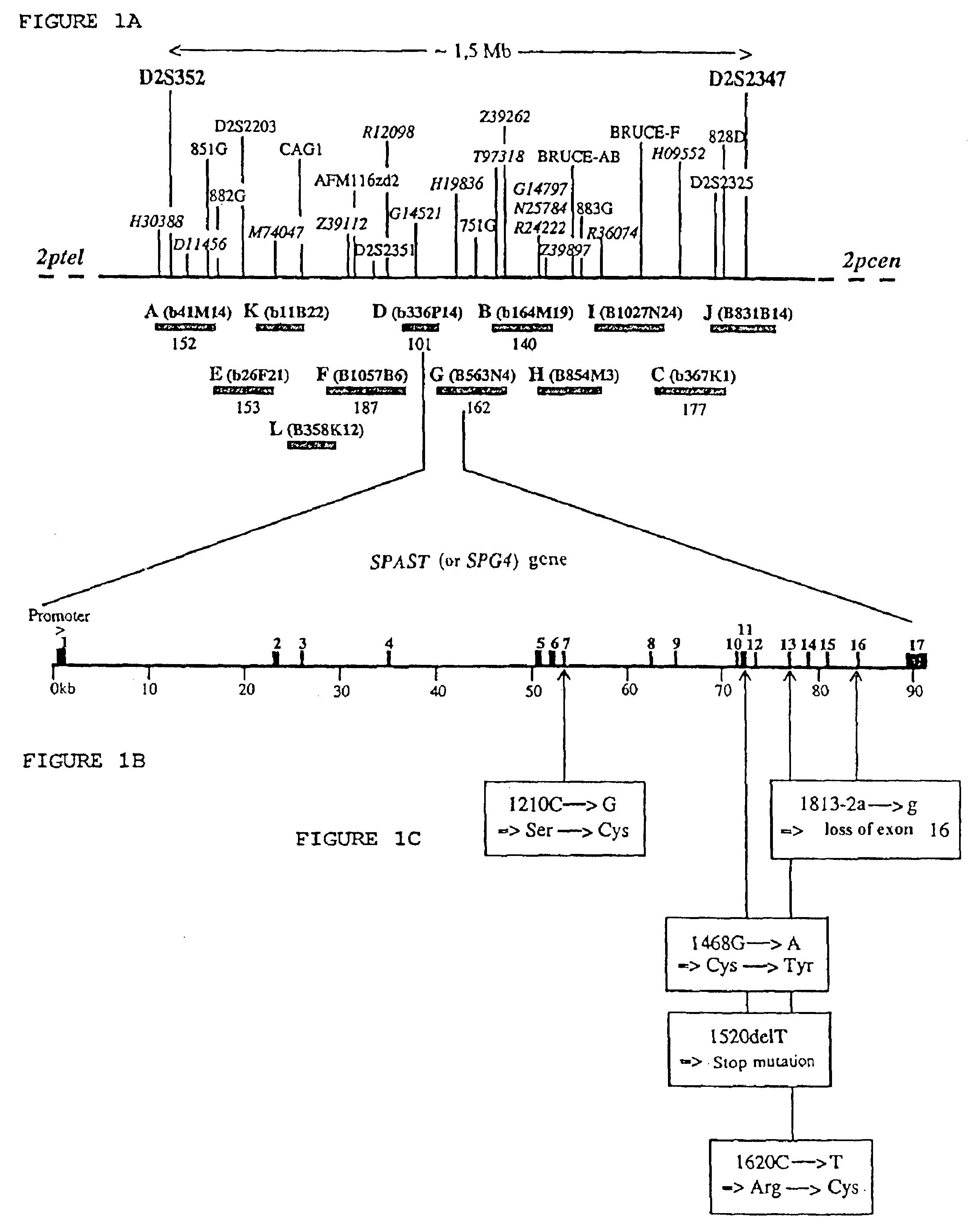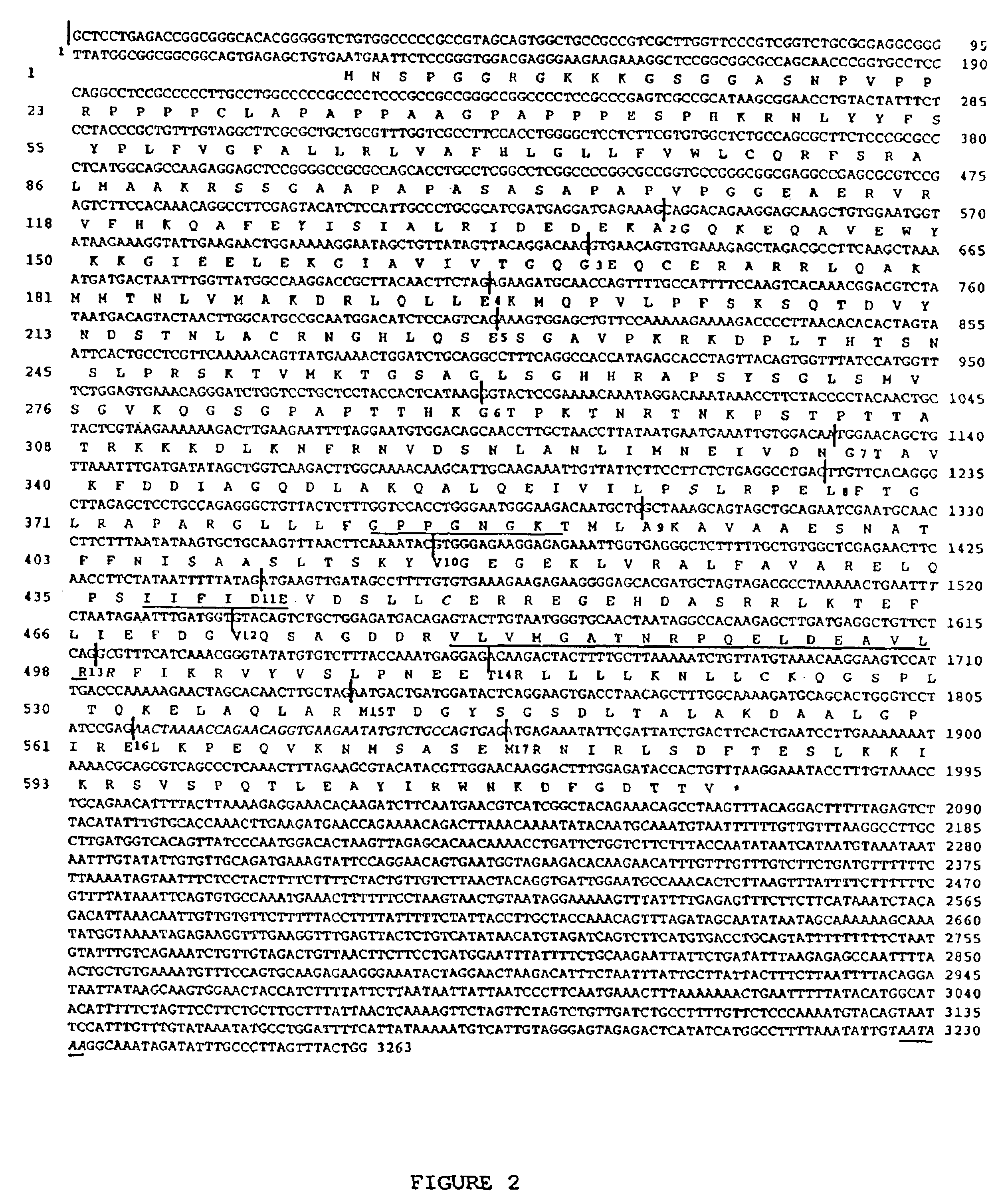Cloning, expression and characterization of the SPG4 gene responsible for the most frequent form of autosomal spastic paraplegia
a technology of autosomal spastic paraplegia and spg4 gene, which is applied in the field of identification and characterization of the spg4 gene encoding spastin, can solve the problems that it has not been possible to confirm the expansion of any of the families, and achieves the effect of reducing the risk of autosomal spastic paraplegia
- Summary
- Abstract
- Description
- Claims
- Application Information
AI Technical Summary
Benefits of technology
Problems solved by technology
Method used
Image
Examples
example 1
Materials and Methods
1) Subcloning and Sequencing of the Candidate Region
[0186]Twelve BACs originating from two human genomic libraries, CITB—978_SKB (sold by Research Genetics) and RPCI-11 (Osoegawa et al., 1998), and covering the SPG4 range, were selected to be sequenced (Hazan et al., Genomics, 60 (3), 309-19, 1999). 40 μg of the DNA of each BAC were partially digested with the CviJI restriction enzyme (CHIMERx) and separated by electrophoresis on 0.4% LMP agarose gel (FMC). DNA fractions, the sizes of which vary in the region of 3, 5 and 10 kb, were eluted with β-agarase (Biolabs) and ligated to a plasmid vector pBAM3, which had been digested with SmaI and dephosphorylated, beforehand, in a ratio of 1× insert per 5× vector. Electrocompetent E. coli DH10B bacteria (GIBCO-BRL) were transformed with the various ligations, by electroporation. Approximately 1 000 to 1 500 subclones per BAC (8 to 10 equivalent genomes), consisting of 20% of clones with inserts at 10 kb, 40% of clones ...
example 2
Analysis of the Sequence of the SPG4 Range
[0197]The analysis of the recombination events made it possible to reduce the SPG4 candidate region to a genetic range of 0 cM between the D2S352 and D2S2347 markers (19, 20). A presequencing map of the SPG4 range composed of 37 BACs was constructed (Hazan et al., in press in Genomics); the candidate region covers a physical distance of approximately of 1.5 Mb. Twelve overlapping BACs, stretching over the SPG4 region, with the exception of a single 4 kb hole between clones A and E, were selected to be sequenced (FIG. 1A). Seven of these BACs (A, B, C, D, E, F and G), covering approximately 70% of the region of interest, have already been sequenced. The sequences of these 7 BACs were compared with those of the nucleic acid and protein databases, and analyzed with four exon prediction programs. These preliminary sequence-analyses made it possible to reveal 14 potential transcription units, including three corresponding to the genes encoding xa...
example 3
Identification of the SPG4 cDNA
[0200]Several successive amplifications by 5′ and 3′ RACE-PCR were carried out on collections of adult liver and brain and fetal brain cDNA, in order to characterize the SPG4 transcript. All the 5′ RACE-PCRs gave amplification products terminating at nt position 263 of the SPG4 cDNA (FIG. 2), which was probably due to the rich GC content of the 5′ region of the transcript (90% of GC in the 60 bp preceding nt position 263). Four overlapping PCR products, covering all of the coding region, were amplified from the cDNAs derived from the lymphoblasts of six control individuals, and entirely sequenced with the aim of verifying the sequence of the SPG4 transcript. Aligning the sequences of all the PCR and RACE-PCR products made it possible to reconstitute a 3263 bp sequence comprising a 1848 bp open reading frame preceded by a 125 bp untranslated 5′ region (5′ UTR for “5′ UnTranslated Region”) and followed by 1290 bp 3′ UTR region including a polyadenylation...
PUM
| Property | Measurement | Unit |
|---|---|---|
| pH | aaaaa | aaaaa |
| temperature | aaaaa | aaaaa |
| temperature | aaaaa | aaaaa |
Abstract
Description
Claims
Application Information
 Login to View More
Login to View More - R&D
- Intellectual Property
- Life Sciences
- Materials
- Tech Scout
- Unparalleled Data Quality
- Higher Quality Content
- 60% Fewer Hallucinations
Browse by: Latest US Patents, China's latest patents, Technical Efficacy Thesaurus, Application Domain, Technology Topic, Popular Technical Reports.
© 2025 PatSnap. All rights reserved.Legal|Privacy policy|Modern Slavery Act Transparency Statement|Sitemap|About US| Contact US: help@patsnap.com



